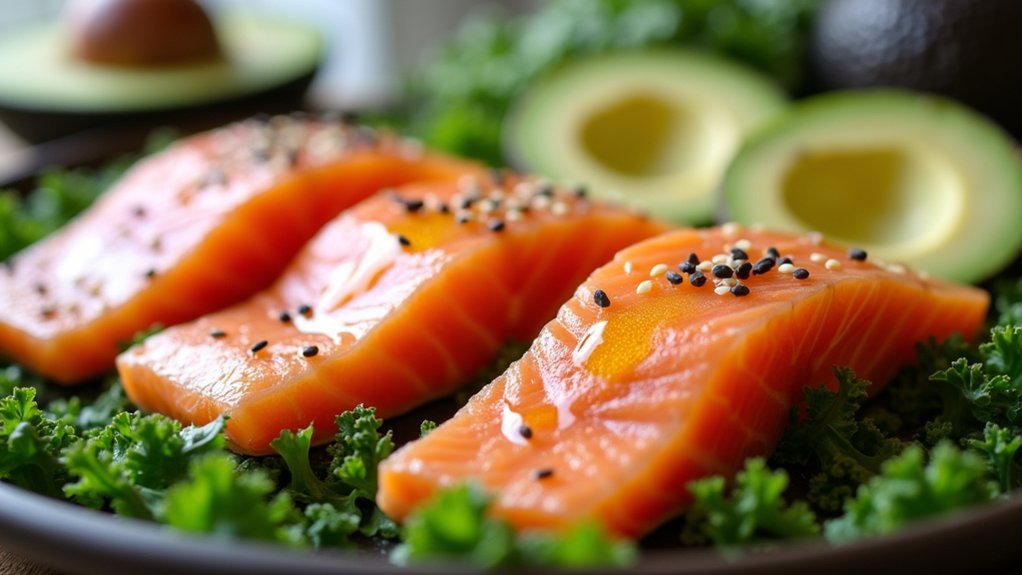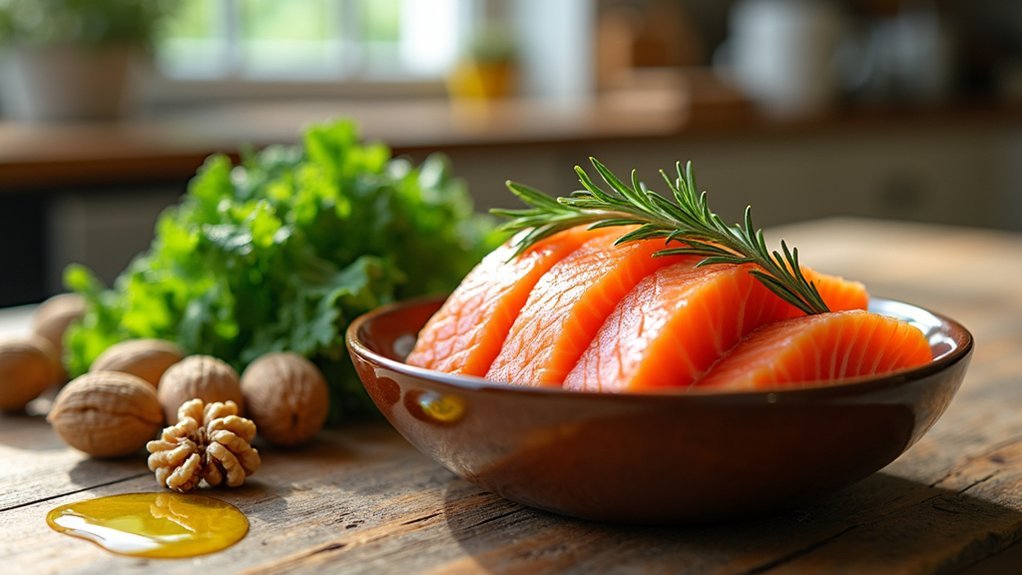You’ll find the most powerful joint pain relief from fatty fish like salmon, mackerel, and sardines, which deliver high concentrations of EPA and DHA omega-3s that directly reduce inflammation. If you’re plant-based, flaxseeds, chia seeds, and walnuts provide ALA omega-3s, though they’re less efficiently converted by your body. Shellfish like mussels and oysters also offer substantial omega-3 benefits. For best results, aim for at least twice-weekly fish consumption to experience the full anti-inflammatory effects these foods can provide.
Fatty Fish: The Ultimate Anti-Inflammatory Powerhouses

When it comes to fighting joint pain naturally, fatty fish like salmon, mackerel, and sardines stand out as nutritional powerhouses that can greatly reduce inflammation in your body.
These fish are loaded with omega-3 fatty acids, specifically EPA and DHA, which actively combat inflammation by reducing inflammatory biomarkers and increasing anti-inflammatory molecules.
You’ll want to eat fatty fish at least twice weekly to experience significant benefits. Research shows that omega-3s from these sources can improve rheumatoid arthritis symptoms and reduce joint pain effectively.
In some cases, high omega-3 doses allow people to discontinue NSAIDs entirely. Higher doses over 2.6 grams/day have been shown to lower inflammatory biomarkers and provide the most therapeutic benefits.
Beyond omega-3s, fatty fish provide vitamin D and selenium, supporting overall health while targeting inflammation at its source.
Plant-Based Omega-3 Sources for Vegetarians and Vegans
For vegetarians and vegans who can’t rely on fatty fish, plant-based omega-3 sources offer excellent alternatives to combat joint inflammation naturally.
Flaxseeds, chia seeds, and hemp seeds pack high levels of ALA omega-3s that you can easily add to smoothies, salads, and baked goods.
Walnuts provide both ALA and powerful antioxidants for additional anti-inflammatory benefits.
Seaweed and algae stand out as rare plant sources containing EPA and DHA, the same omega-3s found in fish.
However, you should know that plant-based ALA doesn’t convert efficiently to EPA and DHA in your body.
You’ll need consistent daily intake of these foods to maximize their joint-protecting benefits, and consider algae-based supplements to guarantee ideal omega-3 levels.
Fish Oil Supplements vs. Whole Food Sources

When you’re deciding between fish oil supplements and whole food sources for joint pain relief, you’ll need to evaluate how well your body absorb each option and what fits your budget and lifestyle.
Your body typically absorbs omega-3s from whole fish more effectively due to the natural nutrient matrix, but supplements offer consistent dosing that’s often more convenient and cost-effective than buying fatty fish regularly. Research indicates that approximately 1,000 mg of fish oil supplement is equivalent to about 3 ounces of fatty fish.
You’ll also find that supplements eliminate concerns about mercury exposure and fishy aftertastes while providing measurable therapeutic doses similar to those used in clinical studies.
Bioavailability and Absorption Rates
Why does your body absorb omega-3s differently depending on whether you pop a supplement or eat a piece of salmon? The chemical form determines how efficiently your body processes omega-3s for joint pain relief.
Re-esterified triglycerides (rTG) deliver 1.76 times better bioavailability than ethyl ester supplements, reaching 134% absorption efficiency. Free fatty acid forms don’t require enzymatic breakdown, achieving 91% bioavailability. Ethyl esters lag at 76%.
Dietary fat dramatically improves absorption. High-fat meals boost ethyl ester uptake from 20% to 60%, while rTG forms increase from 69% to 90%.
Whole food sources like fatty fish naturally provide triglycerides with good bioavailability, plus beneficial micronutrients that supplements lack. Monoglyceride forms may offer clinical advantages for patients with lipid absorption deficits due to their high absorption efficiency.
Cost and Convenience Factors
Understanding how your body processes omega-3s helps you make informed decisions, but practical considerations like cost and convenience often determine whether you’ll stick with supplements or whole food sources long-term.
Fish oil supplements typically offer better value per omega-3 gram than purchasing high-quality salmon or sardines regularly. You’ll spend less upfront and get concentrated doses without meal preparation time.
Supplements easily fit into busy schedules, travel well, and provide exact dosages with longer shelf lives.
However, whole foods deliver additional nutrients like vitamin D, B12, and selenium that enhance omega-3 benefits. While requiring more preparation time and storage space, whole foods encourage varied eating patterns that can reduce long-term healthcare costs through improved overall nutrition habits. Many nutrition experts recommend a balanced strategy of eating fish regularly while using supplements on non-fish days to maximize both convenience and nutritional benefits.
Nuts and Seeds That Combat Joint Inflammation
While many people reach for anti-inflammatory medications to manage joint pain, incorporating specific nuts and seeds into your daily diet can provide a natural, science-backed approach to reducing inflammation.
Walnuts lead the pack with their exceptionally high alpha-linolenic acid (ALA) content, while flaxseeds and chia seeds offer dense omega-3 concentrations alongside fiber and antioxidants.
Walnuts deliver exceptional ALA levels while flaxseeds and chia seeds pack concentrated omega-3s with powerful fiber and antioxidants for joint health.
Hemp seeds provide an ideal omega-6 to omega-3 ratio that supports anti-inflammatory effects.
These foods work by inhibiting inflammatory cytokines and promoting specialized pro-resolving mediators that target joint inflammation directly. Regular walnut consumption can lower blood pressure while delivering powerful anti-inflammatory compounds.
You’ll also benefit from vitamin E, magnesium, and L-arginine, which reduce oxidative stress and improve blood flow to joints.
Aim for one ounce of nuts or 1-2 tablespoons of seeds daily for ideal results.
How Omega-3s Reduce Morning Stiffness and Pain

When you wake up with stiff, aching joints, omega-3 fatty acids are working at the cellular level to combat the inflammatory processes that cause your discomfort.
These powerful nutrients suppress pro-inflammatory cytokines in your joint tissues while promoting anti-inflammatory metabolites that directly reduce morning stiffness.
Your body’s overnight inflammatory response intensifies joint pain, but omega-3s counteract this by inhibiting enzymes that break down cartilage.
They also improve blood flow to your joints, delivering essential nutrients and oxygen that support healing and reduce stiffness.
Clinical studies show that consistent omega-3 intake markedly reduces morning joint pain and improves mobility throughout the day. Research demonstrates that consuming fish twice weekly can significantly reduce disease activity in arthritis patients.
You’ll likely notice decreased reliance on traditional pain relievers as these fatty acids provide natural analgesic effects, particularly beneficial for inflammatory joint conditions.
Marine Sources Beyond Common Fish Options
While salmon and mackerel get most of the attention, you’ll find impressive omega-3 content in shellfish like mussels and oysters that can help reduce your joint inflammation.
Seaweed and algae offer plant-based alternatives that provide the same EPA and DHA benefits without requiring you to consume animal products.
You can also explore lesser-known options like squid and even luxury foods like caviar, which pack substantial omega-3 doses despite being overlooked for their anti-inflammatory properties. Fish oil supplements may help reduce pain and stiffness in joints when dietary sources aren’t sufficient for your needs.
Shellfish Omega-3 Benefits
Shellfish represent an often-overlooked treasure trove of omega-3 fatty acids that can greatly support your joint health goals. Mussels pack the biggest punch, delivering 300-800mg of EPA+DHA per 3 oz serving—outperforming most white fish. Oysters contribute 200-500mg while providing joint-supporting zinc. Crab offers 200-400mg alongside selenium for anti-inflammatory benefits.
| Shellfish | EPA+DHA (3 oz) | Key Joint Benefits |
|---|---|---|
| Mussels | 300-800mg | High omega-3s, selenium, B12 |
| Oysters | 200-500mg | Zinc, copper, vitamin D |
| Crab | 200-400mg | Selenium, B12, phosphorus |
| Shrimp | <200mg | Astaxanthin antioxidants |
| Scallops | <200mg | Quality protein, low mercury |
All shellfish contain minimal mercury levels, making them safe for regular consumption. You’ll also benefit from their complete protein profiles and minerals that support cartilage formation.
Seaweed and Algae
Beyond the familiar fins and shells of traditional seafood lies an underwater forest of omega-3 potential. Seaweed and algae offer plant-based alternatives that deliver EPA and DHA without fish-related concerns.
While seaweed contains moderate omega-3 levels, microalgae like Schizochytrium provide concentrated doses rivaling fish oil supplements.
These marine plants fight joint inflammation by:
- Reducing inflammatory compounds that trigger arthritis pain and stiffness
- Maintaining synovial fluid for better joint lubrication and reduced friction
- Protecting cartilage from degradation that leads to osteoarthritis progression
Algal oil supplements offer controlled omega-3 doses, making them ideal for vegetarians and vegans. Since algae serves as the primary source of omega-3s that fish obtain through consumption, these supplements provide nutritionally equivalent benefits to traditional fish oil.
Though more expensive than fish oil, they bypass sustainability issues while delivering comparable joint health benefits through targeted EPA and DHA content.
Lesser-Known Marine Options
Marine superfoods extend far beyond algae into waters teeming with lesser-known omega-3 powerhouses that can transform your joint health strategy.
Krill oil delivers EPA and DHA alongside astaxanthin, a potent antioxidant that amplifies inflammation-fighting effects. Squid and octopus oils provide similar omega-3 profiles with promising anti-inflammatory potential, though research remains limited.
You’ll find shellfish oils, particularly from oysters and mussels, offer another avenue for omega-3 intake. These marine sources don’t just target joint pain—they support cardiovascular health and provide neuroprotective benefits.
Studies show omega-3s from these sources can reduce your reliance on NSAIDs while improving mobility. These fatty acids work by affecting white blood cells to reduce inflammation throughout your body.
Consider supplements or incorporate whole cephalopods and shellfish into your meals. Always consult your healthcare provider before adding new omega-3 sources to verify they complement your current treatment plan.
Optimal Daily Amounts for Joint Health Benefits
While general health guidelines suggest 250-500 mg of combined EPA and DHA daily, you’ll likely need higher amounts to experience meaningful joint health benefits.
Research shows that individuals with joint conditions often require doses above 500 mg under medical supervision to achieve anti-inflammatory effects and improved mobility.
Joint conditions typically demand omega-3 doses exceeding 500 mg daily under professional guidance for optimal anti-inflammatory results.
Consider these key dosage factors:
- Study Range: Clinical trials use dosages from 376 mg to 4,000 mg daily, with higher doses showing better outcomes.
- Safety Limits: Health organizations recommend not exceeding 5,000 mg of combined EPA and DHA per day.
- Individual Needs: Your specific joint condition may require personalized dosing beyond general recommendations.
Omega-3 and omega-6 compete for the same enzymes in the body, making it important to maintain proper balance for optimal anti-inflammatory properties.
Always consult your healthcare professional to determine the ideal amount for your situation, as they can tailor recommendations based on your joint health needs.
Combining Omega-3 Foods With Other Anti-Inflammatory Nutrients
Although omega-3 fatty acids provide powerful anti-inflammatory benefits on their own, you’ll amplify their joint-protective effects by pairing them with complementary nutrients.
Combine your salmon or sardines with turmeric, which contains curcumin that works synergistically with omega-3s to reduce inflammatory cytokines like TNF-α and IL-6.
Add ginger to your meals for its anti-inflammatory gingerols that enhance joint pain relief. Drizzle extra virgin olive oil over your omega-3-rich foods—its oleocanthal mimics NSAID effects and creates additive benefits.
Include colorful fruits and vegetables high in vitamin C to support collagen synthesis, and don’t forget dark leafy greens for their vitamin K and antioxidants.
This Mediterranean-style approach maximizes your body’s anti-inflammatory response for ideal joint health. Consider incorporating flaxseeds or chia seeds into your anti-inflammatory meals to boost omega-3 intake, especially if you follow a plant-based diet.
Frequently Asked Questions
How Long Does It Take to See Joint Pain Relief From Omega-3 Foods?
You’ll likely notice initial joint pain relief within a few weeks of consuming omega-3 foods regularly. However, you’ll see more significant anti-inflammatory benefits and sustained pain reduction after several months of consistent intake.
Can Omega-3 Foods Replace My Prescription Arthritis Medications Completely?
You can’t replace your prescription arthritis medications completely with omega-3 foods. They’re beneficial as complementary therapy, but you’ll need to consult your healthcare provider before making any medication changes.
Are There Any Side Effects From Eating Too Many Omega-3 Rich Foods?
Yes, you’ll experience side effects if you consume excessive omega-3 rich foods. You’ll face increased bleeding risk, gastrointestinal issues like nausea, potential medication interactions, and possible cholesterol changes requiring medical monitoring.
Do Omega-3 Foods Work Better for Rheumatoid Arthritis or Osteoarthritis?
You’ll find omega-3 foods work better for rheumatoid arthritis than osteoarthritis. They directly target RA’s autoimmune inflammation, providing clearer symptom relief, while their effects on OA’s localized inflammation remain subtler and less definitive.
Should I Avoid Omega-3 Foods if I’m Taking Blood Thinning Medications?
You shouldn’t completely avoid omega-3 foods while taking blood thinners, but you’ll need medical supervision. Don’t exceed 3 grams daily from supplements, and consult your healthcare provider before increasing omega-3 intake.
In Summary
You’ll find the greatest joint pain relief when you incorporate fatty fish like salmon and mackerel into your weekly meals. Don’t overlook plant-based options like flaxseeds and walnuts if you’re vegetarian. Aim for 1-2 grams of omega-3s daily, and you’ll notice reduced morning stiffness within weeks. Combine these foods with turmeric and leafy greens for maximum anti-inflammatory power. Your joints will thank you for making these nutritional changes consistently.





Leave a Reply